The Technical Side. We Aimed at Perfection | Read more at in70mm.com The 70mm Newsletter |
| Written by: L. F. RIDER, MBKS | Date: 01.03.2011 |
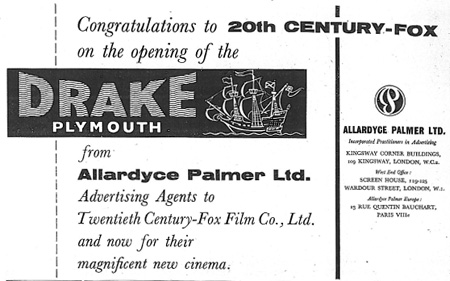 THE Drake, Plymouth, is a
token of our faith in the future of the cinema. From a practical point
of view, it provides a controlled outlet for the product of Twentieth
Century-Fox Films. THE Drake, Plymouth, is a
token of our faith in the future of the cinema. From a practical point
of view, it provides a controlled outlet for the product of Twentieth
Century-Fox Films.Its design and construction have provided my company with the opportunity of putting into practice the principle it has preached - that the screen should represent the fourth wall of the auditorium. The construction of the theatre was first considered in detail two and a half years ago. The site, in the centre of the newly reconstructed area of Plymouth, was leased from the Corporation, and work actually commenced on March 26, 1957. Building was completed by May 25, 1958 - just 14 months of work. |
More in 70mm reading: The Drake, Plymouth, England The Versatile Projectors, Screen and Sound In harmony with the new City Demonstration of Our Faith in the Future The Saga of Todd-AO DP70 / Universal 70-35 / Norelco AAII - The Todd-AO Projector Internet link: |
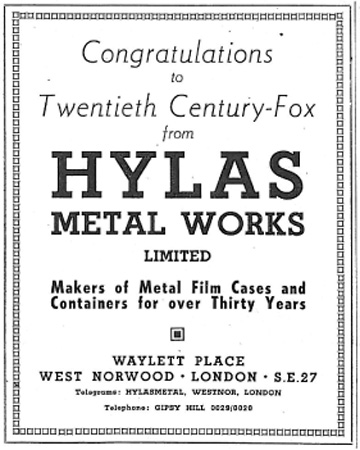 The
original plans of the architect, Leonard Allen FIAA, had to be modified
in some respects when last December the decision was taken to
incorporate provision for showing
Todd-AO films. The
original plans of the architect, Leonard Allen FIAA, had to be modified
in some respects when last December the decision was taken to
incorporate provision for showing
Todd-AO films.George Skouras and I made a detailed inspection to consider what modifications would be needed. Already the plans had provided for the elimination of the proscenium, that hang-over of the old-time theatre, the side walls narrowing down to the curvature of the screen. It was found to be necessary to gain about 7ft. or 8ft. in screen width. The equipping of the projection room presented no problem, since there was already ample space for the enormous Philips projectors. In the design of the theatre three major factors of good presentation had to be considered: projection conditions, sight lines, and acoustics. | |
Level Throw |
|
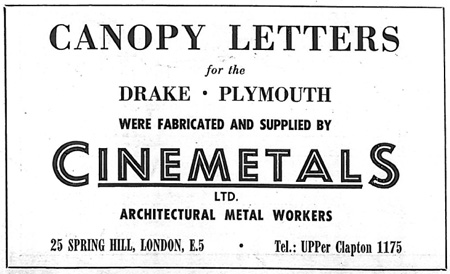 The throw from projectors to screen is 165ft. For
the avoidance of picture distortion a fairly level throw was essential;
the projection angle is only seven degrees, and the screen is tilted to
an angle of three degrees, so that the angle of incidence of the light
on to the screen is only four degrees - so slight as to render distortion
of the picture lines quite negligible. The throw from projectors to screen is 165ft. For
the avoidance of picture distortion a fairly level throw was essential;
the projection angle is only seven degrees, and the screen is tilted to
an angle of three degrees, so that the angle of incidence of the light
on to the screen is only four degrees - so slight as to render distortion
of the picture lines quite negligible. |
|
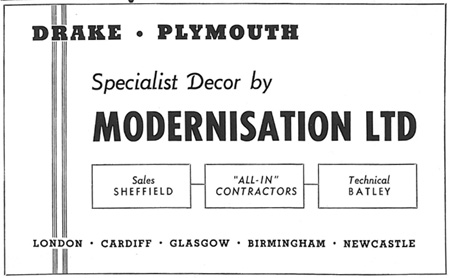 The sight lines from every seat
to the screen have been geometrically evolved on the principle of a
two-row clearance. Although the seating ranks are actually level, the
curvature of the rows means that in effect the side seats are slightly
higher than those in the centre, producing a slightly saucer-shaped
seating area. From every seat vision is perfect. The sight lines from every seat
to the screen have been geometrically evolved on the principle of a
two-row clearance. Although the seating ranks are actually level, the
curvature of the rows means that in effect the side seats are slightly
higher than those in the centre, producing a slightly saucer-shaped
seating area. From every seat vision is perfect.The acoustic conditions of the auditorium were the especial care of R. A. Bull, of Westrex. The cubic capacity of the theatre is actually slightly greater than the optimum figure, but the acoustics have, in fact, exceeded expectations. The rear walls of the auditorium, the front face of the balcony, and a stepped design on the side walls, have been covered with Newall's Paxtiles, and tests have shown that hearing conditions are perfect in every part of the seating area. | |
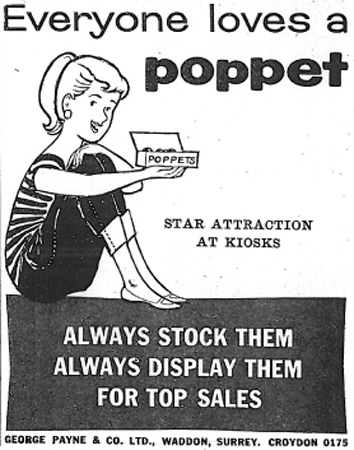 The colour scheme of the auditorium, carried out by
Modernisation, Ltd. has been conceived with a view to assuring optimum
projection conditions. The colours used are light blue, beige (for the Paxtiles) and deep red; the proportion of the darker colour increases in
a stepped design towards the screen, so that there are no light-coloured
areas near the screen which may be illuminated by stray light from the
picture, and so distract attention. With the same object, there is no
clock beside the screen, and the exit boxes are quite unobtrusive. The colour scheme of the auditorium, carried out by
Modernisation, Ltd. has been conceived with a view to assuring optimum
projection conditions. The colours used are light blue, beige (for the Paxtiles) and deep red; the proportion of the darker colour increases in
a stepped design towards the screen, so that there are no light-coloured
areas near the screen which may be illuminated by stray light from the
picture, and so distract attention. With the same object, there is no
clock beside the screen, and the exit boxes are quite unobtrusive.Comfort of patrons has been another major consideration. The 1.650 Turner seats are of one design only (except for the covering) and have Dunlopillo cushions and, except for the front stalls, padded arms. The spacing between rows is quite exceptional, ranging from 34in. to 48in., either sufficient to avoid the need for patrons standing to allow others to pass. | |
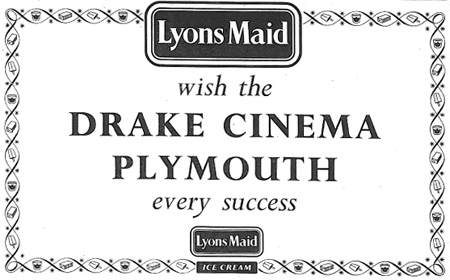 The decision to incorporate
Todd-AO presentation raised certain difficulties in regard to the
screen, since a feature of the process is a deeply curved screen. A
depth of curvature from arc to chord of 8ft. was decided upon, whereas
for CinemaScope and other projection systems a depth of only 3ft. was
preferred. The decision to incorporate
Todd-AO presentation raised certain difficulties in regard to the
screen, since a feature of the process is a deeply curved screen. A
depth of curvature from arc to chord of 8ft. was decided upon, whereas
for CinemaScope and other projection systems a depth of only 3ft. was
preferred.Methods of curving the screen used in the States were considered; these, however, all depended upon the flexing of the actual screen frame. These systems were abandoned as unsatisfactory. In collaboration with Twentieth Century-Fox. Andrew Smith Harkness devised a method of articulating the horizontal members of a conventional type of frame, hinges permitting the end sections to be moved over a considerable arc. Thanks to the width of the screen-lacing, the screen itself does not follow the bend of the frame, but assumes an even curvature. Within a few minutes the screen curvature can be modified from 3ft. to 8½ft, depth. The choice of screen surface is an important factor, since previous demonstrations have been marred by re-reflection of light across the curved screen. Tests demonstrated that the new Harkness screen material, Perlux, was sufficiently directional to avoid such re-reflection, yet not so directional as to provide a picture of uneven brightness from every seat. | |
Aspect Ratios |
|
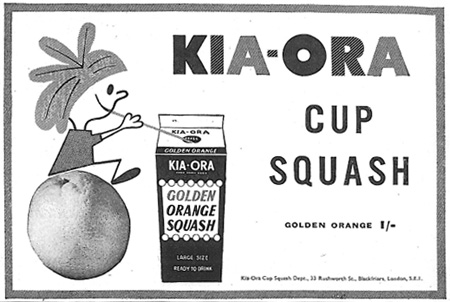 Four picture-aspect ratios have been provided
without the need for variation of the Vertical masking. The side masking
is moved by an independent controller at each side of the frame,
providing ratios of 1.375, 1.75 (normally used for 35-mm. non-anamorphic
films), 2.2 (for Todd-AO) and 2.35 (for Mag-optical prints). The maximum
width of picture is 60ft. making the screen one of the largest in the
country. Four picture-aspect ratios have been provided
without the need for variation of the Vertical masking. The side masking
is moved by an independent controller at each side of the frame,
providing ratios of 1.375, 1.75 (normally used for 35-mm. non-anamorphic
films), 2.2 (for Todd-AO) and 2.35 (for Mag-optical prints). The maximum
width of picture is 60ft. making the screen one of the largest in the
country.The lighting of the auditorium is provided by concealed lights inside a suspended feature which is the major decoration of the hall. When the decision was reached to equip for Todd-AO, the obvious choice of projectors was the Philips Multi-Purpose 70/35-mm. projector, which has already been widely installed in the States by Magna, sponsor of Todd-AO, and in other countries throughout the world. This projector, installed by J. Frank Brockliss Ltd., is, of course, built to run Todd-AO and all types of 35-mm. film, with optical or magnetic sound. The Drake is, therefore, able to show any possible product. | |
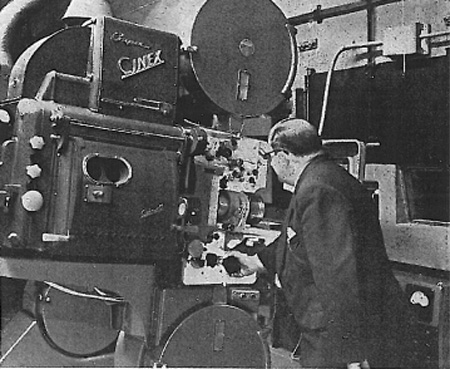 Chief projectionist R.
J. Macnamara adjusting one of the Philips Multi-Purpose projectors Chief projectionist R.
J. Macnamara adjusting one of the Philips Multi-Purpose projectorsAfter consideration of the possibilities of British-made arc lamps, it was finally decided that the only type of lamp capable of providing sufficient lumens to illuminate the 60ft. picture was the arc widely used in American drive-in theatres, the Ashcraft Super-Cinex. Running at 150 to 160 amps., this provides a well-lit picture equally with Todd-AO and through the smaller apertures of 35-mm. film. Constancy of light is assured by the Micronic crater control device, which makes use of the most sensitive part of the light, the edge of the cone from the mirror, to provide absolutely constant positioning of the positive crater. The highly efficient gate-cooling of the Philips projector is supplemented by the use of the Balcold mirror, 18in. in diameter, which is not silvered but is rear-coated in such a manner that, while most of the visible light is reflected, 48 to 50 per cent of the heat is transmitted and therefore kept off the film. The carbon trim used is 13.5-mm. and 10-mm. |
|
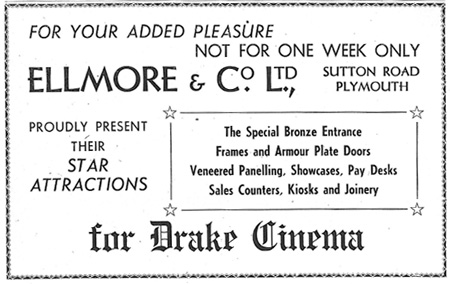 The cost of the lenses alone
would have sufficed to equip completely an old-time cinema. For showing
Todd-AO films, American Optical lenses of 4.8-in. focus are used, with minifiers. For CinemaScope, Bausch & Lomb Super-Cinephor have been
chosen; for wide-screen of 1.75 ratio, Oude Delft; and for normal
35-mm., GB-Kalee Series S. The principal factor in the selection of
lenses of these various makes has been the back-focus. The cost of the lenses alone
would have sufficed to equip completely an old-time cinema. For showing
Todd-AO films, American Optical lenses of 4.8-in. focus are used, with minifiers. For CinemaScope, Bausch & Lomb Super-Cinephor have been
chosen; for wide-screen of 1.75 ratio, Oude Delft; and for normal
35-mm., GB-Kalee Series S. The principal factor in the selection of
lenses of these various makes has been the back-focus.Incidentally the massive lens mount of the Philips projector at last makes it possible to clamp the backing lens, screw the anamor-phoser on to it, and still get no vibration. The sound outputs of the Philips projectors already suited the characteristics of the Westrex sound reproduction system. Since I was myself associated with Westrex for 20 years, I was naturally delighted that the sound installation should have been entrusted to that company. | |
Five Racks |
|
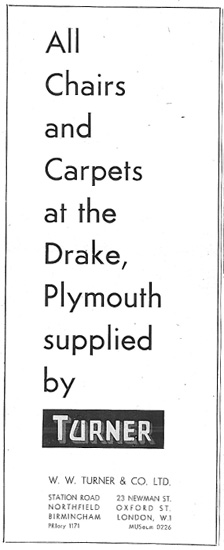 The Westrex power amplifiers and power units are
housed in five standard racks and provision has been made for the
reproduction of standard optical track, single track, four-track and
six-track magnetic. Each channel consists of a pre-amplifier feeding
into two power amplifiers with parallel inputs. The outputs, however,
retain their individuality and feed the two halves of a loudspeaker
assembly comprising two HF horns and four LF units in a vented box
baffle. The Westrex power amplifiers and power units are
housed in five standard racks and provision has been made for the
reproduction of standard optical track, single track, four-track and
six-track magnetic. Each channel consists of a pre-amplifier feeding
into two power amplifiers with parallel inputs. The outputs, however,
retain their individuality and feed the two halves of a loudspeaker
assembly comprising two HF horns and four LF units in a vented box
baffle.There are five speaker assemblies backstage, and no fewer than 24 ambient speakers, which are housed in recesses in the side and rear walls of the auditorium. A unique feature of the Westrex equipment is the deaf-aid system, which makes use of inductive feed, so that the deaf-aid units need not be plugged in. The whole of the centre blocks of seats, in the stalls and balcony, are wired so that a deaf person can choose any seat in this area, and need not unplug his attachment to allow people to pass him. The unit itself is transistorised for compactness and lightness. A 20-watt amplifier feeds the induction loops. The total speech output in the theatre, including the stage amplification system, is 500 watts. Both film and stage sound are controlled from a panel situated in the circle. Faders for the various circuits are ganged together, providing complete control. Numerous projection accessories - spools, splicers, rewind bench, spool cupboards - have been supplied by Robert Rigby Ltd. Two Stelmar spotlights are included, installed by J. Frank Brockliss Ltd. |
|
Rectification |
|
 To supply the projection arcs
and spotlights, four Hewittic rectifiers are installed in the rectifier
room. Two, with an output of 180 amps each, feed the Ashcraft lamps, and
a third serves at present as a stand-by, but could supply any other
equipment which future developments may require. A fourth rectifier has
dual output to feed the two Stelmars. Outputs are specially smoothed to
prevent pick-up in the magnetic heads. To supply the projection arcs
and spotlights, four Hewittic rectifiers are installed in the rectifier
room. Two, with an output of 180 amps each, feed the Ashcraft lamps, and
a third serves at present as a stand-by, but could supply any other
equipment which future developments may require. A fourth rectifier has
dual output to feed the two Stelmars. Outputs are specially smoothed to
prevent pick-up in the magnetic heads.In the design of the projection suite, particular regard has been paid to the comfort and convenience of the projection staff. The rest-room will, when time permits, be comfortably furnished, and a well-equipped workshop will be provided. |
|
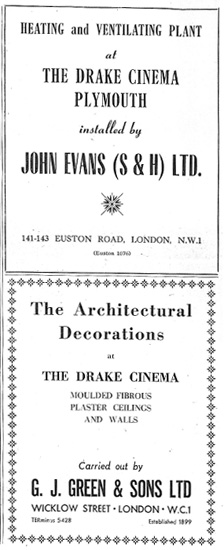 The
need for adaptability to future developments has throughout been borne
in mind. A fifth pair of portholes is provided in the projection room,
which may house a third Philips projector should it ever become
desirable, or allow for so far unforeseen future developments. To ensure
flexibility in the wiring, the contractor, Troughton & Young, has used
ducting almost entirely which, although more costly than conduit,
provides easier access to the circuits. The
need for adaptability to future developments has throughout been borne
in mind. A fifth pair of portholes is provided in the projection room,
which may house a third Philips projector should it ever become
desirable, or allow for so far unforeseen future developments. To ensure
flexibility in the wiring, the contractor, Troughton & Young, has used
ducting almost entirely which, although more costly than conduit,
provides easier access to the circuits.All of us who have been concerned with the conception, design and construction of the Drake have spared no trouble or expense to make it the finest cinema in the country - the first cinema specially built to suit the new techniques. No longer can the modern projection techniques be confined within a structure built for the projection systems of the past; Cinema-Scope, Todd-AO and any other processes that the future may hold can be shown to their finest advantage in the theatre of which Plymouth is so proud. | |
| Go: back - top - back issues - news index Updated 22-01-25 |
